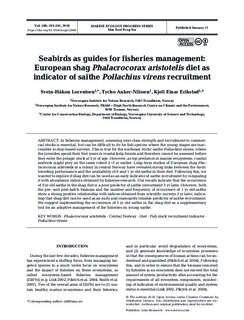| dc.contributor.author | Lorentsen, Svein Håkon | |
| dc.contributor.author | Anker-Nilssen, Tycho | |
| dc.contributor.author | Erikstad, Kjell E | |
| dc.date.accessioned | 2018-02-06T15:05:26Z | |
| dc.date.available | 2018-02-06T15:05:26Z | |
| dc.date.created | 2018-01-15T14:31:16Z | |
| dc.date.issued | 2018 | |
| dc.identifier.citation | Marine Ecology Progress Series. 2018, 586, 193-201. | nb_NO |
| dc.identifier.issn | 0171-8630 | |
| dc.identifier.uri | http://hdl.handle.net/11250/2483030 | |
| dc.description.abstract | In fisheries management, assessing year-class strength and recruitment to commercial stocks is essential, but can be difficult to do for fish species where the young stages are inaccessible to ship-based surveys. This is true for the northeast Arctic saithe Pollachius virens, where the juveniles spend their first years in coastal kelp forests and therefore cannot be assessed before they enter the pelagic stock at 3 yr of age. However, as top predators in marine ecosystems, coastal seabirds might prey on the same cohort 2−3 yr earlier. Long-term studies of European shag Phalacrocorax aristotelis at a colony in central Norway have revealed strong links between the birds’ breeding performance and the availability of 0 and 1 yr old saithe in their diet. Following this, we wanted to explore if shag diet can be used as an early indicator of saithe recruitment by comparing it with abundance indices obtained by fisheries research. Our results indicate that the occurrence of 0 yr old saithe in the shag diet is a poor predictor of saithe recruitment 3 yr later. However, both the pre- and post-hatch biomass and the number and frequency of occurrence of 1 yr old saithe show a strong positive relationship with indices obtained from scientific surveys 2 yr later, indicating that shag diet can be used as an early and reasonably reliable predictor of saithe recruitment. We suggest implementing the occurrence of 1 yr old saithe in the shag diet as a supplementary tool for an adaptive management of the fisheries on young saithe. Phalacrocorax aristotelis · Central Norway · Diet · Fish stock recruitment indicator · Pollachius virens | nb_NO |
| dc.language.iso | eng | nb_NO |
| dc.publisher | Inter-Research | nb_NO |
| dc.rights | Navngivelse 4.0 Internasjonal | * |
| dc.rights.uri | http://creativecommons.org/licenses/by/4.0/deed.no | * |
| dc.title | Seabirds as guides for fisheries management: European shag Phalacrocorax aristotelis diet as indicator of saithe Pollachius virens recruitment | nb_NO |
| dc.type | Journal article | nb_NO |
| dc.type | Peer reviewed | nb_NO |
| dc.description.version | publishedVersion | nb_NO |
| dc.subject.nsi | VDP::Zoologiske og botaniske fag: 480 | nb_NO |
| dc.subject.nsi | VDP::Zoology and botany: 480 | nb_NO |
| dc.source.pagenumber | 193-201 | nb_NO |
| dc.source.volume | 586 | nb_NO |
| dc.source.journal | Marine Ecology Progress Series | nb_NO |
| dc.identifier.doi | 10.3354/meps12440 | |
| dc.identifier.cristin | 1543091 | |
| dc.relation.project | Andre: Norwegian Ministry of Climate and Environment | nb_NO |
| dc.relation.project | Andre: Norwegian Environment Agency | nb_NO |
| dc.relation.project | Andre: Norwegian Ministry of Petroleum and Energy | nb_NO |
| dc.description.localcode | © The authors 2018. Open Access under Creative Commons by Attribution Licence. Use, distribution and reproduction are unrestricted. Authors and original publication must be credited. | nb_NO |
| cristin.unitcode | 194,0,0,0 | |
| cristin.unitname | Norges teknisk-naturvitenskapelige universitet | |
| cristin.ispublished | true | |
| cristin.fulltext | original | |
| cristin.qualitycode | 2 | |

